|
The
Royalty of Mid-Century Modern
by
Bob Brooke
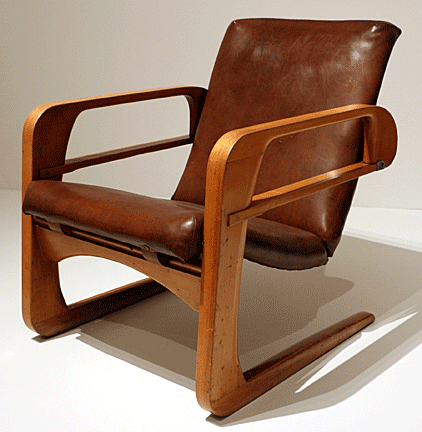 When
many people hear the term “mid-century modern,” they automatically think
of furniture with clean lines and a lack of detail. And while many
associate the Mid-Century Modern style with the years 1945 to 1965, one
of the earliest examples of that type of furniture was the Airline
armchair, designed by Kem Weber in 1934. This unique chair featured the
sleek geometry of Art Deco, a retail price of just under $25, and was
meant to be shipped in a cardboard box and assembled by the buyer, much
like IKEA furniture is today, Unfortunately, only 200 or so of the
chairs ever made it to production and even fewer got shipped. When
many people hear the term “mid-century modern,” they automatically think
of furniture with clean lines and a lack of detail. And while many
associate the Mid-Century Modern style with the years 1945 to 1965, one
of the earliest examples of that type of furniture was the Airline
armchair, designed by Kem Weber in 1934. This unique chair featured the
sleek geometry of Art Deco, a retail price of just under $25, and was
meant to be shipped in a cardboard box and assembled by the buyer, much
like IKEA furniture is today, Unfortunately, only 200 or so of the
chairs ever made it to production and even fewer got shipped.
Furniture designs tend to be as simple and practical as they are
beautiful. And many famous mid-century furniture designers created
pieces for mass-market consumption and pricing.
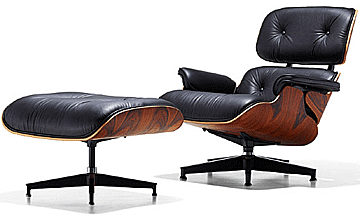
The modern look that took root in the 1940s and expanded into 1950s,
'60s, and early '70s in America reflects on innovative Bauhaus design
originating in Germany decades earlier, around the same time that Art
Deco was on the rise. Designers like Charles and Ray Eames built on this
modernist ideal with their colorful furniture made of bent plywood, and
plastic chairs molded to fit the curve of the body. Their designs are
considered to be classics among modernism fans.
Charles and Ray Eames
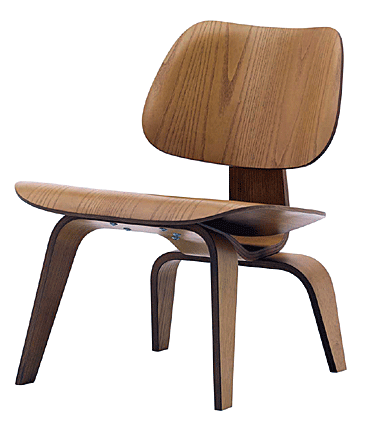 When
it comes to the royalty of mid-century modern, the name Charles Eames
tops the list. He and his wife Ray did more to foster this dramatic
modern style than any other designers. When
it comes to the royalty of mid-century modern, the name Charles Eames
tops the list. He and his wife Ray did more to foster this dramatic
modern style than any other designers.
In 1930, Charles Eames started his own architectural office. He began
extending his design ideas beyond architecture and received a fellowship
to Cranbrook Academy of Art in Michigan, where he eventually became head
of the design department. And that’s where he met his wife and business
partner.
Eames and his best friend, Eero Saarinen, entered the Organic Furniture
Design Competition, sponsored by the Museum of Modern Art in 1940. Their
goal was to mold a single piece of plywood into a chair; the Organic
Chair was born out of this attempt. The chair won first prize, but its
form was unable to be successfully mass produced. Eames and Saarinen
considered it a failure, as the tooling for molding a chair from a
single piece of wood had not yet been invented. Ray stepped in to help
with the graphic design for their entry.
One of their first products was a birch child’s chair and stool
manufactured by the Molded Plywood Division of Evans Products. The
Eameses were more successful than Weber, but the run was still limited
to 5,000 pieces, and only 1,000 of their LCW (Lounge Chair Wood) chairs
were ever made.
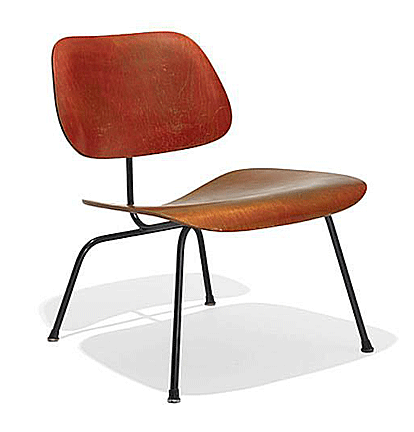 In
1946, Evans Products began producing the Eameses’ molded plywood
furniture. Their molded plywood chair was called “the chair of the
century” by the influential architectural critic Esther McCoy. Soon
production was taken over by Herman Miller, Inc., who continues to
produce the furniture in the United States today. In
1946, Evans Products began producing the Eameses’ molded plywood
furniture. Their molded plywood chair was called “the chair of the
century” by the influential architectural critic Esther McCoy. Soon
production was taken over by Herman Miller, Inc., who continues to
produce the furniture in the United States today.
The Eames’ partnership with Herman Miller was more fruitful, however.
With Miller, the Eameses created the DCM (Dining Chair Metal), a
two-piece chair whose plywood sections were attached to a chromed frame.
In addition, they produced the DAR chair, which had a rigid fiberglass
shell that could be molded in a rainbow of colors and set on a variety
of metal bases and legs, including a rocker. With Miller, in 1956, the
Eameses also produced the Lounge Chair and Ottoman, which featured
molded rosewood plywood and leather upholstery.
Ray and Charles worked together as creative partners and employed a
diverse creative staff. Among their most recognized designs is the Eames
Lounge Chair and the Eames Dining Chair. As with their earlier molded
plywood work, the Eameses pioneered technologies, such as using
fiberglass as a materials for mass-produced furniture. Their unique
synergy led to a whole new look in furniture. Lean and modern. Playful
and functional. Sleek, sophisticated, and beautifully simple. That was
and is the “Eames look.”
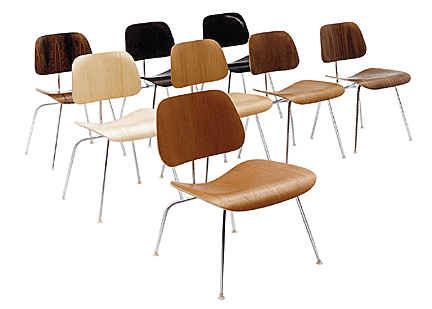
Among the many important designs the two
originated were the molded-plywood DCW (Dining Chair Wood) and DCM
(Dining Chair Metal with a plywood seat) in 1945, the Eames Lounge Chair
in 1956, the Aluminum Group furniture in 1958, and the Eames Chaise in
1968.
And in 1958, Herman Miller relocated the tooling and resources for the
mass production of Eames designs to its headquarters in Zeeland,
Michigan. Today, Herman Miller, along with their European counterpart
Vitra, remain the only licensed manufacturers of Eames furniture.
Eero Saarinen
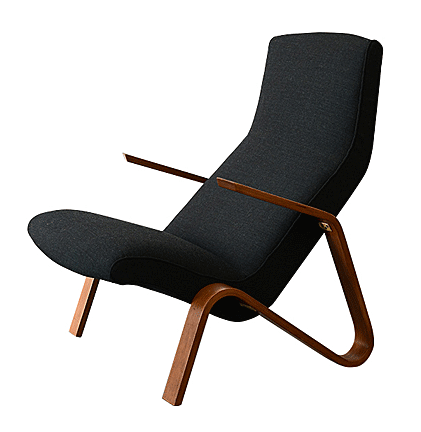 Saarinen,
the son of the director of the Cranbrook Academy, first received
critical recognition for a chair designed together with Charles Eames
for the Organic Design in Home Furnishings, for which they received
first prize. The Knoll Furniture Company, founded by Hans Knoll, who
married Saarinen family friend Florence (Schust) Knoll, produced
Saarinen’s Tulip chair, as well as all his others. Saarinen,
the son of the director of the Cranbrook Academy, first received
critical recognition for a chair designed together with Charles Eames
for the Organic Design in Home Furnishings, for which they received
first prize. The Knoll Furniture Company, founded by Hans Knoll, who
married Saarinen family friend Florence (Schust) Knoll, produced
Saarinen’s Tulip chair, as well as all his others.
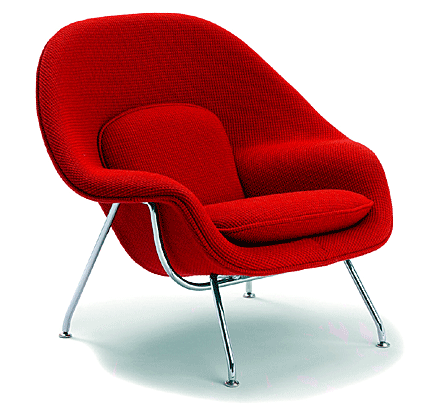 During
his long association with Knoll, Saarinen designed many important pieces
of furniture, including the Grasshopper lounge chair and ottoman in
1946, the Womb chair and ottoman in 1948, the Womb settee in 1950, side
and arm chairs between 1948 and 1950, and his most famous Tulip or
Pedestal group in 1956, which featured side and arm chairs, dining,
coffee and side tables, as well as a stool. All of these designs were
highly successful except for the Grasshopper lounge chair, which,
although in production through 1965, didn’t fare well in the
marketplace. During
his long association with Knoll, Saarinen designed many important pieces
of furniture, including the Grasshopper lounge chair and ottoman in
1946, the Womb chair and ottoman in 1948, the Womb settee in 1950, side
and arm chairs between 1948 and 1950, and his most famous Tulip or
Pedestal group in 1956, which featured side and arm chairs, dining,
coffee and side tables, as well as a stool. All of these designs were
highly successful except for the Grasshopper lounge chair, which,
although in production through 1965, didn’t fare well in the
marketplace.
Harry Bertoia
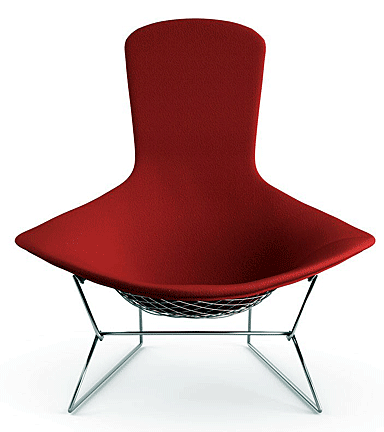 Harry
Bertoia was a sculptor whose wire-frame Diamond chairs, made by Knoll,
are sometimes mistaken for the work of the Eameses. And that’s not a
coincidence. Harry
Bertoia was a sculptor whose wire-frame Diamond chairs, made by Knoll,
are sometimes mistaken for the work of the Eameses. And that’s not a
coincidence.
Bertoia also learned about designing chairs from Charles Eames and Eero
Saarinen at Cranbrook Academy when they entered and won the Organic
Furniture Design Competition sponsored by the Museum of Modern Art.
Bertoia developed his initial chair design ideas while working with
Charles Eames and others in California in the late 1940s.
He was extremely instrumental in achieving the flexible plywood seat
with tubular frame that eventually became the Eames chair. But it became
known only as the Eames chair, with no mention of Bertoia or the other
co-workers.
Bertoia, frustrated by the lack of recognition, left Eames went to work
for the Point Lomas Naval Electronics Laboratory. Part of his work at
the lab was to scrutinize the human body and chart how to design
equipment such as control panels and knobs with respect to comfort of
the human reach and grip—today known as ergonomics—which it contributed
later to the design of his well-fitting, practical chairs.
Metal was Bertoia’s material of choice, and he played with it until
arising at the wire grid concept that could be shaped at will. He not
only created the airy design of his chairs, but also devised the
production molds used for mass manufacture.
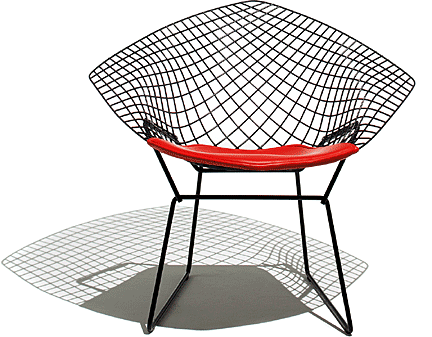 In
1950 Hans Knoll commissioned Bertoia to design several chairs. His
designs transcended the barrier between decorative and functional
design, balancing successfully between sculpture and furniture. And at a
time when most chairs were made of rigid wood, Bertoia’s furniture, with
its welded wire and springy feel, were truly innovative. In
1950 Hans Knoll commissioned Bertoia to design several chairs. His
designs transcended the barrier between decorative and functional
design, balancing successfully between sculpture and furniture. And at a
time when most chairs were made of rigid wood, Bertoia’s furniture, with
its welded wire and springy feel, were truly innovative.
Bertoia produced his chairs with varying amounts of upholstery over
their light grid work. He had to make them by hand at first because
there wasn’t a suitable mass production process known at the time.
Bertoia's "Diamond Chairs" have a base of lattice-like metal with a
fabric cover. There were five different sculptural, open-weave metal
designs in the original Bertoia Collection for Knoll, which began
producing them in 1953 and is still doing so today. Other designs in the
line included the side chair, bird chair, bar stool and wide diamond
chair, all released in the early 1950s. The Children’s chair came in
1955.
Edward Wormley
Edward Wormley, known for his high-quality American furniture, went to
study at the Art Institute of Chicago in 1926. Funds ran out, so he got
a job as an interior designer for Marshall Fields & Company department
store. During the Depression, Wormley met the president of Dunbar
Furniture Company of Berne, Indiana, who hired him to upgrade their
product line. In 1944 Dunbar decided to focus strictly on modern lines.
Wormley incorporated European and Scandinavian innovations to produce a
successful line.
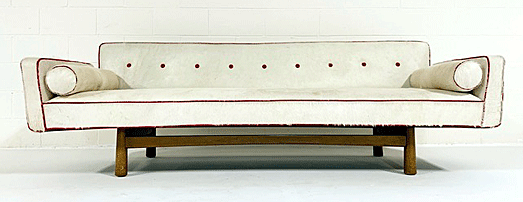
His eye for quality and the exacting craftsmanship at Dunbar helped
create furniture that was elegant, understated and exceptionally
well-made. Though Wormley was never at the forefront of modern design,
he took the best elements from classical, historical design and
translated them into pieces aimed at middle class homeowners.
As part of the Janus line in 1957, Wormley created tile-topped
occasional tables that combined the best methods of modern production
with the tile traditions of Tiffany and Otto Natzler.
Through four decades Wormley remained one of the most prominent American
furniture designers. His talent combining fine craftmanship together
with both modernist and historical traits made for sophisticated design
with wide appeal, especially for the customer who didn’t embrace more
avant-garde modernism.
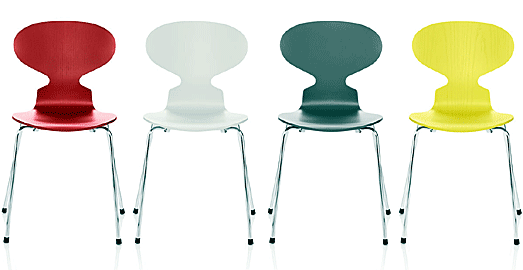
Scandinavian Designers
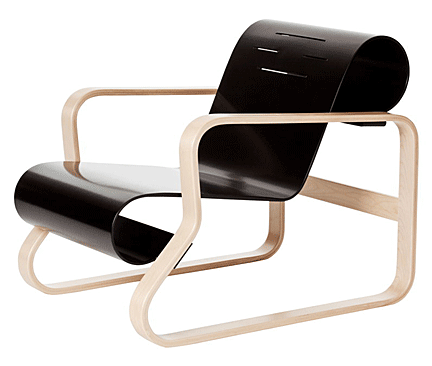 Mid-century
modern design also embraced Scandinavian furniture design. The best of
it came from two designers—Alvar Aalto and Arne Jacobsen. Mid-century
modern design also embraced Scandinavian furniture design. The best of
it came from two designers—Alvar Aalto and Arne Jacobsen.
Noted Finnish designer Alvar Aalto’s armchair, model No. 397, created in
1932, also bridged the gap between Art Deco and modernism. Aalto made
his armchair, often referred to as the Springleaf, of bent and molded
birch plywood. And a decade later, Charles and Ray Eames figured out how
to create strong compound curves in plywood using Aalto’s materials and
techniques.
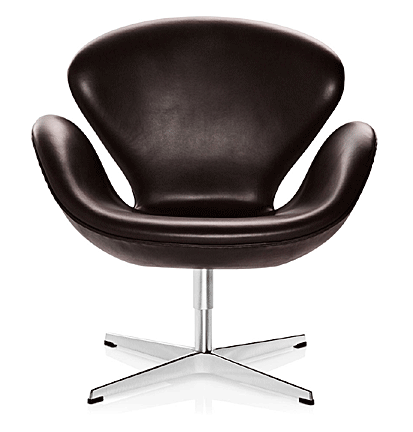 Danish
designer Arne Jacobsen, the father of a style that came to be known as
Danish Modern, created chairs with names like Ant, Egg, and Swan,
drawing inspiration from the modernist designs of Charles and Ray Eames.
Jacobsen conceived every detail of the SAS Royal Hotel in Copenhagen,
Denmark. One of the furniture pieces for it was his signature Egg Chair
with matching footstool, designed in 1958. But he also conceived
flatware, cocktail sets, and tea service sets. Danish
designer Arne Jacobsen, the father of a style that came to be known as
Danish Modern, created chairs with names like Ant, Egg, and Swan,
drawing inspiration from the modernist designs of Charles and Ray Eames.
Jacobsen conceived every detail of the SAS Royal Hotel in Copenhagen,
Denmark. One of the furniture pieces for it was his signature Egg Chair
with matching footstool, designed in 1958. But he also conceived
flatware, cocktail sets, and tea service sets.
<
Back to Antiques Archives
Next Article >
|
